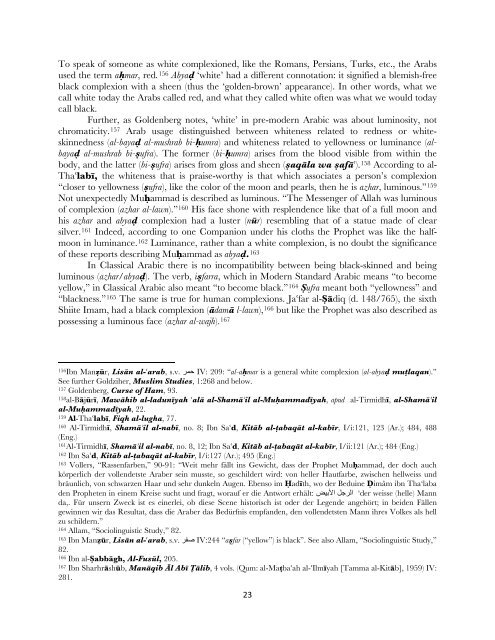“Anyone who says that the Prophet is black should be killed”: The ...
“Anyone who says that the Prophet is black should be killed”: The ...
“Anyone who says that the Prophet is black should be killed”: The ...
You also want an ePaper? Increase the reach of your titles
YUMPU automatically turns print PDFs into web optimized ePapers that Google loves.
To speak of someone as white complexioned, like <strong>the</strong> Romans, Persians, Turks, etc., <strong>the</strong> Arabs<br />
used <strong>the</strong> term aÈmar, red. 156 Abya∙ ‘white’ had a different connotation: it signified a blem<strong>is</strong>h-free<br />
<strong>black</strong> complexion with a sheen (thus <strong>the</strong> ‘golden-brown’ appearance). In o<strong>the</strong>r words, what we<br />
call white today <strong>the</strong> Arabs called red, and what <strong>the</strong>y called white often was what we would today<br />
call <strong>black</strong>.<br />
Fur<strong>the</strong>r, as Golden<strong>be</strong>rg notes, ‘white’ in pre-modern Arabic was about luminosity, not<br />
chromaticity. 157 Arab usage d<strong>is</strong>tingu<strong>is</strong>hed <strong>be</strong>tween whiteness related to redness or whiteskinnedness<br />
(al-baya∙ al-mushrab bi-Èumra) and whiteness related to yellowness or luminance (albaya∙<br />
al-mushrab bi-ßufra). <strong>The</strong> former (bi-Èumra) ar<strong>is</strong>es from <strong>the</strong> blood v<strong>is</strong>ible from within <strong>the</strong><br />
body, and <strong>the</strong> latter (bi-ßufra) ar<strong>is</strong>es from gloss and sheen (ßaq§la wa ßaf§#). 158 According to al-<br />
Tha#labÊ, <strong>the</strong> whiteness <strong>that</strong> <strong>is</strong> pra<strong>is</strong>e-worthy <strong>is</strong> <strong>that</strong> which associates a person’s complexion<br />
“closer to yellowness (ßufra), like <strong>the</strong> color of <strong>the</strong> moon and pearls, <strong>the</strong>n he <strong>is</strong> azhar, luminous.” 159<br />
Not unexpectedly MuÈammad <strong>is</strong> descri<strong>be</strong>d as luminous. “<strong>The</strong> Messenger of Allah was luminous<br />
of complexion (azhar al-lawn).” 160 H<strong>is</strong> face shone with resplendence like <strong>that</strong> of a full moon and<br />
h<strong>is</strong> azhar and abya∙ complexion had a luster (når) resembling <strong>that</strong> of a statue made of clear<br />
silver. 161 Indeed, according to one Companion under h<strong>is</strong> cloths <strong>the</strong> <strong>Prophet</strong> was like <strong>the</strong> halfmoon<br />
in luminance. 162 Luminance, ra<strong>the</strong>r than a white complexion, <strong>is</strong> no doubt <strong>the</strong> significance<br />
of <strong>the</strong>se reports describing MuÈammad as abya∙. 163<br />
In Classical Arabic <strong>the</strong>re <strong>is</strong> no incompatibility <strong>be</strong>tween <strong>be</strong>ing <strong>black</strong>-skinned and <strong>be</strong>ing<br />
luminous (azhar/abya∙). <strong>The</strong> verb, ißfarra, which in Modern Standard Arabic means “to <strong>be</strong>come<br />
yellow,” in Classical Arabic also meant “to <strong>be</strong>come <strong>black</strong>.” 164 ‘ufra meant both “yellowness” and<br />
“<strong>black</strong>ness.” 165 <strong>The</strong> same <strong>is</strong> true for human complexions. Ja#far al-‘§diq (d. 148/765), <strong>the</strong> sixth<br />
Shiite Imam, had a <strong>black</strong> complexion (§dam§ l-lawn), 166 but like <strong>the</strong> <strong>Prophet</strong> was also descri<strong>be</strong>d as<br />
possessing a luminous face (azhar al-wajh). 167<br />
156 Ibn Maníår, L<strong>is</strong>§n al-#arab, s.v. ﺮﻤﺣ IV: 209: “al-aÈmar <strong>is</strong> a general white complexion (al-abya∙ muãlaqan).”<br />
See fur<strong>the</strong>r Goldziher, Muslim Studies, 1:268 and <strong>be</strong>low.<br />
157 Golden<strong>be</strong>rg, Curse of Ham, 93.<br />
158 al-B§jårÊ, Maw§hib al-ladunÊyah #al§ al-Sham§"il al-MuÈammadÊyah, apud al-TirmidhÊ, al-Sham§"il<br />
al-MuÈammadÊyah, 22.<br />
159 Al-Tha#labÊ, Fiqh al-lugha, 77.<br />
160 Al-TirmidhÊ, Sham§"il al-nabÊ, no. 8; Ibn Sa#d, Kit§b al-ãabaq§t al-kabÊr, I/i:121, 123 (Ar.); 484, 488<br />
(Eng.)<br />
161 Al-TirmidhÊ, Sham§"il al-nabÊ, no. 8, 12; Ibn Sa#d, Kit§b al-ãabaq§t al-kabÊr, I/ii:121 (Ar.); 484 (Eng.)<br />
162 Ibn Sa#d, Kit§b al-ãabaq§t al-kabÊr, I/i:127 (Ar.); 495 (Eng.)<br />
163 Vollers, “Rassenfar<strong>be</strong>n,” 90-91: “Weit mehr fällt ins Gewicht, dass der <strong>Prophet</strong> MuÈammad, der doch auch<br />
körperlich der vollendetste Ara<strong>be</strong>r sein musste, so geschildert wird: von heller Hautfar<strong>be</strong>, zw<strong>is</strong>chen hellwe<strong>is</strong>s und<br />
bräunlich, von schwarzen Haar und sehr dunkeln Augen. E<strong>be</strong>nso im \adÊth, wo der Beduine 4imâm ibn Tha‘laba<br />
den <strong>Prophet</strong>en in einem Kre<strong>is</strong>e sucht und fragt, worauf er die Antwort erhält: ﺾﻴﺑﻷﺍ ﻞﺟﺮﻟﺍ ‘der we<strong>is</strong>se (helle) Mann<br />
da,. Für unsern Zweck <strong>is</strong>t es einerlei, ob diese Scene h<strong>is</strong>tor<strong>is</strong>ch <strong>is</strong>t oder der Legende angehört; in <strong>be</strong>iden Fällen<br />
gewinnen wir das Resultat, dass die Ara<strong>be</strong>r das Bedürfn<strong>is</strong> empfanden, den vollendetsten Mann ihres Volkes als hell<br />
zu schildern.”<br />
164 Allam, “Sociolingu<strong>is</strong>tic Study,” 82.<br />
165 Ibn Maníår, L<strong>is</strong>§n al-#arab, s.v. ﺮﻔﺻ IV:244 “aßfar (“yellow”) <strong>is</strong> <strong>black</strong>”. See also Allam, “Sociolingu<strong>is</strong>tic Study,”<br />
82.<br />
166 Ibn al-‘abb§gh, Al-Fusål, 205.<br />
167 Ibn Sharhr§shåb, Man§qib $l AbÊ •§lib, 4 vols. (Qum: al-Maãba#ah al-#IlmÊyah [Tamma al-Kit§b], 1959) IV:<br />
281.<br />
23
















